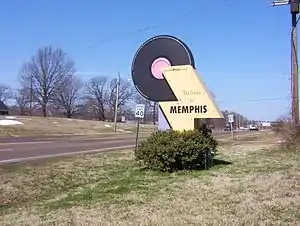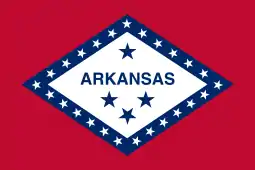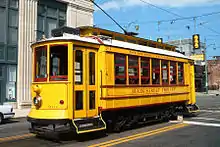Hernando de Soto Bridge
The Hernando de Soto Bridge is a through arch bridge carrying Interstate 40 across the Mississippi River between West Memphis, Arkansas, and Memphis, Tennessee. The architectural design is a continuous cantilevered cable-stayed steel through arch, with bedstead endposts. Memphians also call the bridge the "New Bridge",[2] as it is newer than the Memphis & Arkansas Bridge (carrying Interstate 55) downstream, and the "M Bridge", due to its distinctive shape. It is of similar construction to the Sherman Minton Bridge between Louisville, Kentucky, and New Albany, Indiana.
Hernando de Soto Bridge | |
|---|---|
 Hernando de Soto Bridge photographed from the Memphis Pyramid | |
| Coordinates | 35°09′10″N 90°03′50″W |
| Carries | 6 lanes of |
| Crosses | Mississippi River |
| Locale | West Memphis, Arkansas, and Memphis, Tennessee |
| Other name(s) | The M Bridge, Memphis Bridge, Mississippi Bridge, New Bridge |
| Maintained by | TDOT and AHTD |
| ID number | 79I00400001 |
| Characteristics | |
| Design | Cable-stayed, through arch |
| Material | Steel |
| Pier construction | Concrete |
| Total length | 9,432.6 feet (2,875 m) |
| Width | 90 feet (27 m) |
| Longest span | 900 feet (274 m) |
| Clearance below | 109 feet (33 m) |
| History | |
| Opened | August 2, 1973 |
| Statistics | |
| Daily traffic | 37,308 (2018)[1] |
| Location | |

| |
History
Preliminary planning for the river crossing began in 1960 as part of Interstate 40 alignment studies for the Memphis - Little Rock corridor, which was constructed in segments between 1963 and 1968. Before the Hernando de Soto Bridge was completed, traffic going across the river was carried across the Mississippi River by the Interstate 55/US Highway 64/70/79/61 Memphis & Arkansas Bridge crossing, located 2 miles (3.2 km) southwest.
Construction of the Hernando de Soto Bridge began in May 1967. The double-arch bridge was opened to automobile traffic on August 2, 1973. A dedication ceremony for the bridge occurred on August 17, 1973.[3] The bridge cost approximately $57 million (equivalent to $256 million in 2019[4]).[3]
The bridge is named for 16th century Spanish explorer Hernando de Soto who explored this stretch of the Mississippi River, and died south of Memphis.
Bridge illumination
At night, the bridge is illuminated by 200 sodium vapor lights along its "M" shape structure. The bridge was first illuminated on September 5, 1986, after $373,000 of private funds had been raised to fund the cost and installation of the lights. Due to some river traffic having issues with the lights at night reflecting on the water, the city installed a remote switch to toggle the lights on and off briefly while the vessel passes under the bridge.[5] During the 2011 Mississippi River floods, the bridge became dark for about 2 months because the transformers that supply the electricity for the lights were removed to prevent damage to them by flood waters. The bridge was re-lit in a ceremony which occurred on June 21, 2011.
It was announced after the opening of the Big River Crossing along the Harahan Bridge to the south that the existing sodium vapor lights along the Hernando Desoto Bridge would be replaced with a new LED lighting display, thus making the Hernando Desoto Bridge the second bridge over the Mississippi River to be lit as such after the Harahan. The new display can be lit in sync with the Harahan Bridge and display various color patterns dependent upon special occasions or requests. Both displays have been created under an initiative called "Mighty Lights." The $14 million privately funded project is expected to begin June 4 and be unveiled October 27, nearly exactly 2 years after the opening/initial illumination of the Big River Crossing.[6]
Seismic retrofit project
Since 2000, the bridge has been under a seismic retrofitting project, allowing it to withstand a 7.7 magnitude earthquake, the similar magnitude of earthquakes during the 1811–12 New Madrid earthquakes. The retrofit project is also a means to protect the bridge as it is located within 100 miles (161 km) of the New Madrid Seismic Zone, serves as a major cargo route, and traffic thoroughfare across the river. Work is being completed as funds are available. As part of this project, the main span, approaches, and ramps for the downtown exit are being retrofitted. A bridge about 1 mile (1.6 km) west of the main span was rebuilt with earthquake considerations. As the main span (the "M" portion) is located entirely within Tennessee, the funding formula is split 60%/40% between TDOT and AHTD. To date, $175 million has been spent with another $80 million expected.[7]
Incidents
On August 23, 2007, an inspector discovered that a bridge pier on the approach bridge west of the river had settled overnight, and the bridge was subsequently closed to perform a precautionary inspection. The bridge was reopened later that day.[8]
Gallery
 Hernando de Soto Bridge from Martyr's Park in Memphis
Hernando de Soto Bridge from Martyr's Park in Memphis Hernando de Soto Bridge illuminated at night
Hernando de Soto Bridge illuminated at night Crossing into Memphis on the Hernando de Soto Bridge
Crossing into Memphis on the Hernando de Soto Bridge
See also
 Transport portal
Transport portal Engineering portal
Engineering portal United States portal
United States portal United States portal
United States portal- List of crossings of the Lower Mississippi River
References
- Tennessee Department of Transportation. "Traffic History". ArcGIS. Esri. Retrieved July 18, 2020.
- Teresa R. Simpson (February 17, 2008). "About.com:Memphis:The Mississippi River". About.com. Archived from the original on November 18, 2008. Retrieved November 11, 2008.
- "I-40 Bridge Dedicated After Political Disclaimers". The Tennessean. United Press International. August 18, 1973. p. 7. Retrieved June 17, 2020 – via Newspapers.com.
- Thomas, Ryland; Williamson, Samuel H. (2020). "What Was the U.S. GDP Then?". MeasuringWorth. Retrieved September 22, 2020. United States Gross Domestic Product deflator figures follow the Measuring Worth series.
- "The Commercial Appeal". The Commercial Appeal. Archived from the original on October 17, 2012. Retrieved April 26, 2018.
- Tom Charlier (May 29, 2018). "The Commercial Appeal". The Commercial Appeal. Retrieved May 29, 2018.
- "TDOT". www.tdot.state.tn.us. Archived from the original on May 6, 2015. Retrieved April 26, 2018.
- Chris Conley, Richard Locker (August 27, 2007). "Bridge reopens after review". Commercial Appeal. Memphis, TN. Archived from the original on May 17, 2011. Retrieved April 21, 2008.CS1 maint: uses authors parameter (link)






